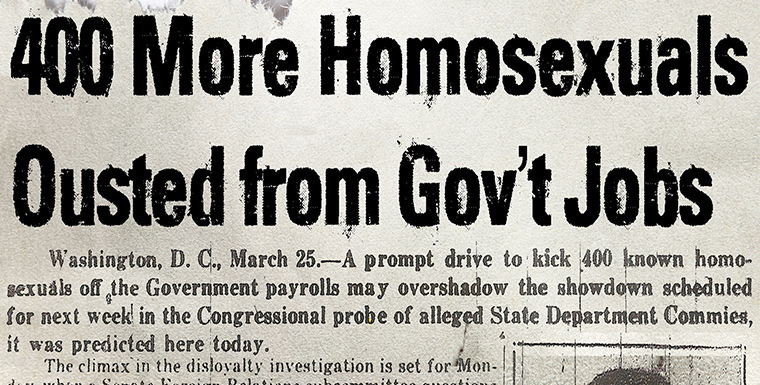The Lavender Scare
During the era of McCarthyism, a time when extreme paranoia was at its height, a lesser-known witch hunt arose: The Lavender Scare. The Lavender Scare was a moral panic about homosexual people in the United States, leading to their removal in government employment. The fear was that gay men and lesbians were national security risks and communist sympathizers. During the 50s and even into the 60s, interrogations about a person’s sexuality was common in the workplace. They would be asked questions like “Do you identify as a homosexual?” and “Have you ever participated in same-sex sexual relations?”
The term “Lavender Scare” grew to fame through David K. Johnson's book written in 2004, which studied this anti-homosexual campaign. He originally drew this title from the term “lavender lads”, often used by Senator Everett Dirksen as a label for homosexual males. At the time, Senator Dirksen explained that the Republican victory would mean the removal of these “lavender lads” from the State Department.
Before the Lavender Scare and after World War II, LGBTQ people from rural communities gathered in cities where they could keep their anonymity. However, in 1947, the United States Park Police the Sex Perversion Elimination Act, resulting in at least 500 arrests and 76 people charged.
The Lavender Scare originally began due to the ideas of morality that connected queer and homosexual people to communists. At the time, homosexuals were viewed as sinful and perverted, and as people who lacked mental and moral strength. To government officials, this was the issue: if a person could live this kind of double life, how could they be trusted to keep government secrets?
This made it extremely difficult to publicly be part of the LGBTQ community. While most homosexuals were closeted before, being publicly LGBTQ in the 50s was nearly impossible without having high consequences. This resulted in the break up of small LGBTQ communities who were afraid of federal employment discrimination, and also the formation of a homogeneous culture in the government.
While many laws since then have overturned such homophobic measures, it is shocking and horrifying to think that our country’s government participated in such homophobic actions in the past.
Sources:


I thought that this was a very interesting blog that really highlighted the extent of hate that plagued America during the Cold War and McCarthyism. After doing a little more research into the sociological and psychological factors that influenced people into why people direct hate towards such people, I found one article stating that people believed Western civilization also had a duty to contain "effeminate" races. Everyone, even including President Richard Nixon blamed homosexuals for events as unrelated as the fall of Greece and Rome. Eventually during this time period, "perversion" and "communism" carried the same derogatory connotation.
ReplyDeleteSource:
https://daily.jstor.org/the-lavender-scare/
This post was very informative, especially seeing as we just learned about the riots that took place as a result of the McCarthyism perspective. These riots combined the race hatred in the country and the fear of communism into something else entirely. It is clear that a common theme of the era was that people who hated one group would tend to hate other groups as well. Based on this knowledge, I was truly not surprised to find that something like the Lavender Scare also took place during this time period.
ReplyDeleteI found this post interesting, especially when you compared the ways that the Red Scare helped contribute to the Lavender Scare. Something interesting I found is the Lavender Offense Victim Exoneration Act, or LOVE Act, which aims to make amends to those who were targets of the government ousting caused by the Sex Perversion Elimination Act. During McCarthy's pressing of government officials, he often incorporated homophobic reasons to remove individuals from power, such as Case 14 and Case 62, who were both individuals that had been fired but later rehired for their sexuality in the past. These individuals, according to McCarthy has some "peculiar mental twists" what were often associated with communist individuals.
ReplyDeletehttps://www.archives.gov/publications/prologue/2016/summer/lavender.html
https://www.nbcnews.com/feature/nbc-out/lavender-scare-bill-seeks-address-midcentury-purging-gay-federal-workers-n1003881
Your explanation of the Lavender Scare was both clear and detailed. Upon further research about the government's harsh actions against those of the community, I found that once the governmental pressures on homosexuals became too intense, they began to resist. Frank Kameny fought against his dismissal from his position as an astronomer by taking his case to the Supreme Court. He argued that he was being treated as a second class citizen and that the case was not about morality or national security, but of human rights. Although he lost, Kameny went on to help other homosexuals who were fired from government positions to fight against their dismissals in court.
ReplyDeletehttp://outhistory.org/items/show/1425
I think this is a super intresting topic and I am super glad that someone decided to write a blog about it! The discrimination against the gay community has been constantly looked over in this time period and I think it's a super important part of the history of this period that deserves to be talked about and acknowledged. I thought the neglect of this issue is similar to that of the discrimination of the gay community in the Holocaust. This was another aspect of history regarding gay discrimination that was often not acknowledged.
ReplyDelete